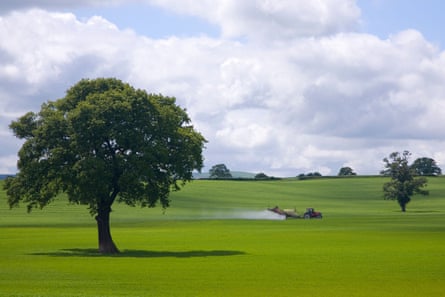Conservation measures over the past 30 years have failed to stop the decline of insects on British farmland, a new report shows. Populations of bees, spiders, ground beetles and hoverflies have disappeared twice as fast in areas intensely farmed for crops, according to the paper, which looked at citizen science data on more than 1,500 invertebrate species.
Although there was a push to intensify agriculture after the second world war, since the early 90s more sustainable and wildlife-friendly farming practices have emerged, with EU agri-environment funding made available for farmers to plant hedgerows and wild flowers, alongside better regulation of pesticides. However, these have not managed to stem biodiversity loss.
“In fact, for most of the taxonomic groups included in this study, declines appear to have accelerated over recent years,” the researchers write in the paper Invertebrate Biodiversity Continues to Decline in Cropland, published in the journal Proceedings of the Royal Society B.
The study suggests that, despite having impact locally, wildlife-friendly farming measures have not been employed on a big enough scale to have an impact nationally. However, the scientists believe that post-Brexit changes to UK agricultural policy could help farming to achieve those goals.
Lead researcher Francesca Mancini, from the UK Centre for Ecology and Hydrology, said: “The main message to policymakers is that despite the efforts we have put in in the last 30 years, this is just not enough. We really need to review what we’ve done and try to do better for the future for diversity, but also for the future of agriculture.”
Insects are crucial to ecosystems because they provide food for other creatures, pollinate crops and recycle nutrients.
The study compared areas in Britain with high and low cropland cover and found that declines are worse in areas with high cropland cover. The researchers divided Britain into 1 sq km cells that were categorised depending on how much cropland – predominantly oilseed rape and cereals such as barley – was being grown within them. They did not look at land used to graze animals.
In areas with more than 50% cropland cover, invertebrate species had disappeared from 5% of sites that were occupied in 1990, while in areas with less than 50% cropland cover, they had disappeared from 2% of sites.
Out of the six taxonomic groups examined, spiders and bees were the most negatively affected in areas with more than 50% cropland cover, showing a 7% and 4% decline respectively. Researchers suspect declines were worse before 1990, but lack sufficient data.
“They are pretty sizeable declines,” said Mancini. “Because of the introduction of environment schemes and the improvement of policy and practice since the 1990s, we were hoping that we would find a slowing down or trends becoming stable. But that’s not the case, and things are still declining.”
The paper suggested a number of possibilities, including the general intensification of agriculture, changes to the type and efficacy of insecticides, habitat loss around cropland, and the climate crisis and other weather-related events such as drought.
In 2019, a global scientific analysis of insect decline concluded that agriculture was the main cause – in particular, the heavy use of pesticides. The mass of insects is falling by 2.5% a year, which means they could vanish within a century.

The new findings mirror those of a study last month, which showed intensive agriculture was the greatest driver of bird declines in Europe, with the use of pesticides and fertilisers most to blame, according to the data collected by thousands of citizen scientists in 28 countries – including the UK – over nearly 40 years.
“Sadly, insect declines are not surprising,” said Prof Jane Hill from the University of York, who is president of the Royal Entomological Society and was not involved in this research. “The findings help us to understand the patterns of insect declines, and so contribute to solving the puzzle of how to protect invertebrates and reverse declines.”
Find more age of extinction coverage here, and follow biodiversity reporters Phoebe Weston and Patrick Greenfield on Twitter for all the latest news and features

